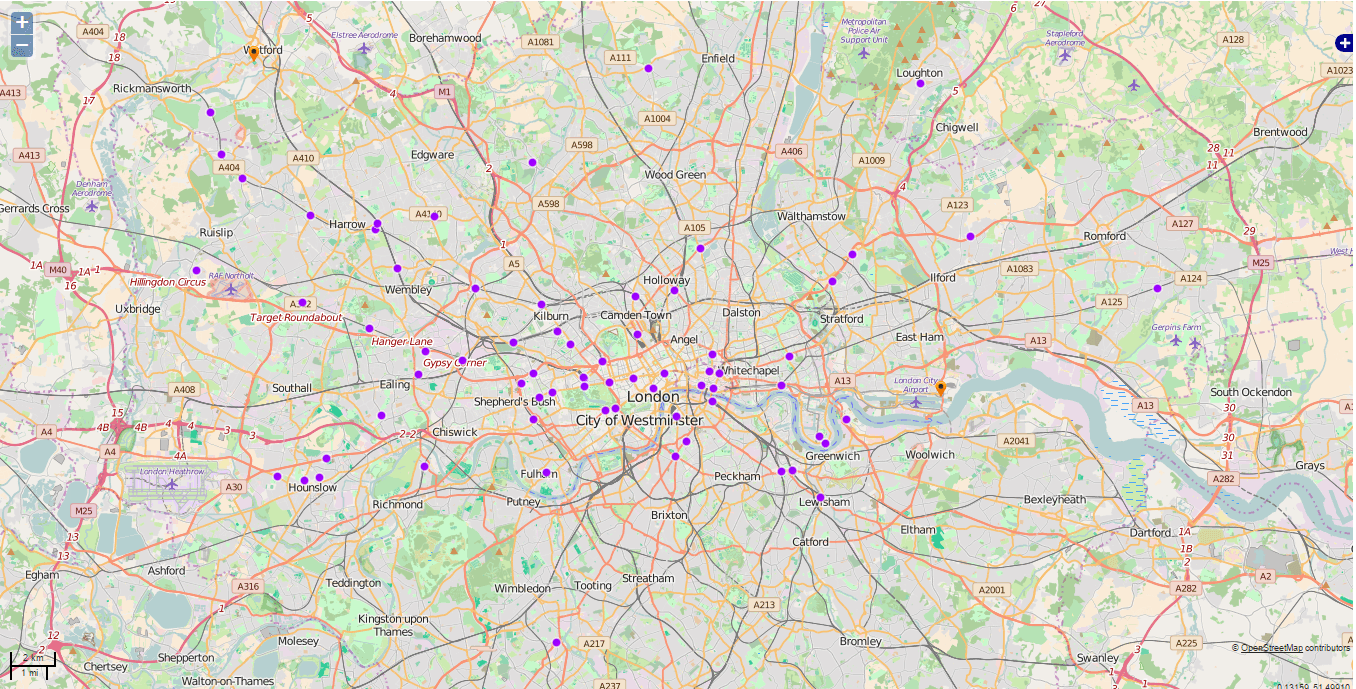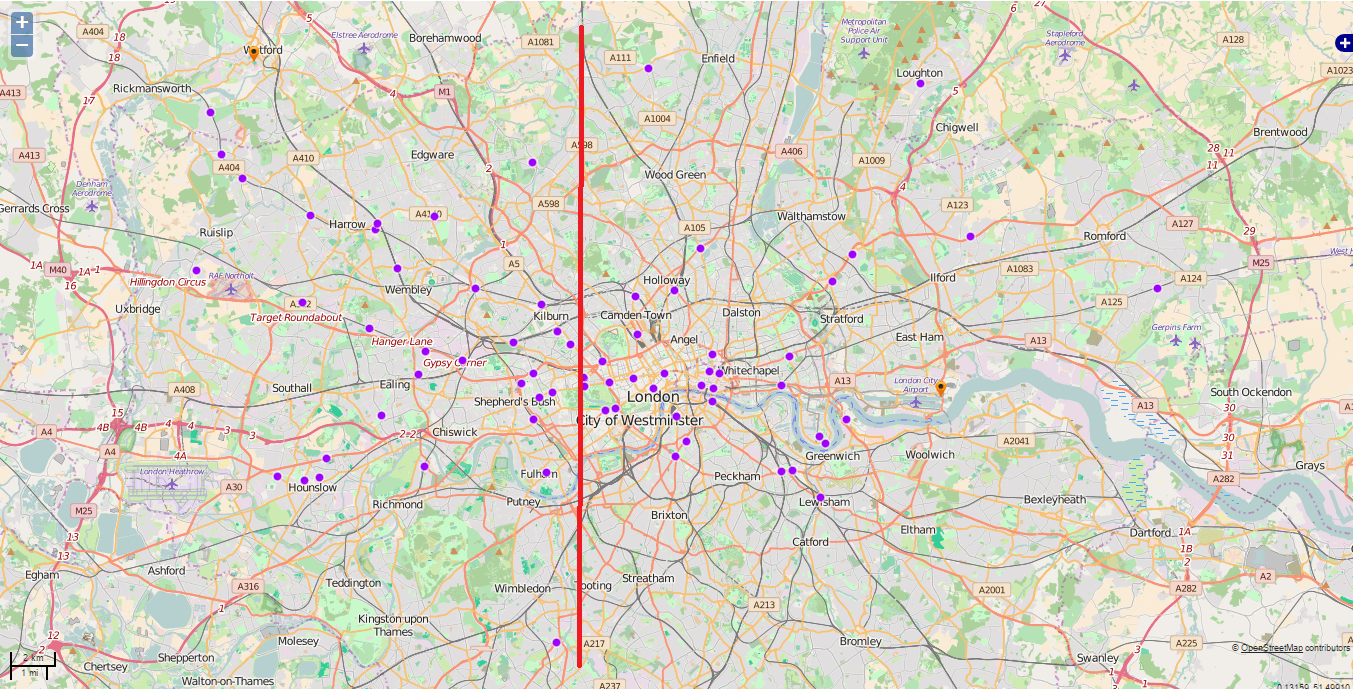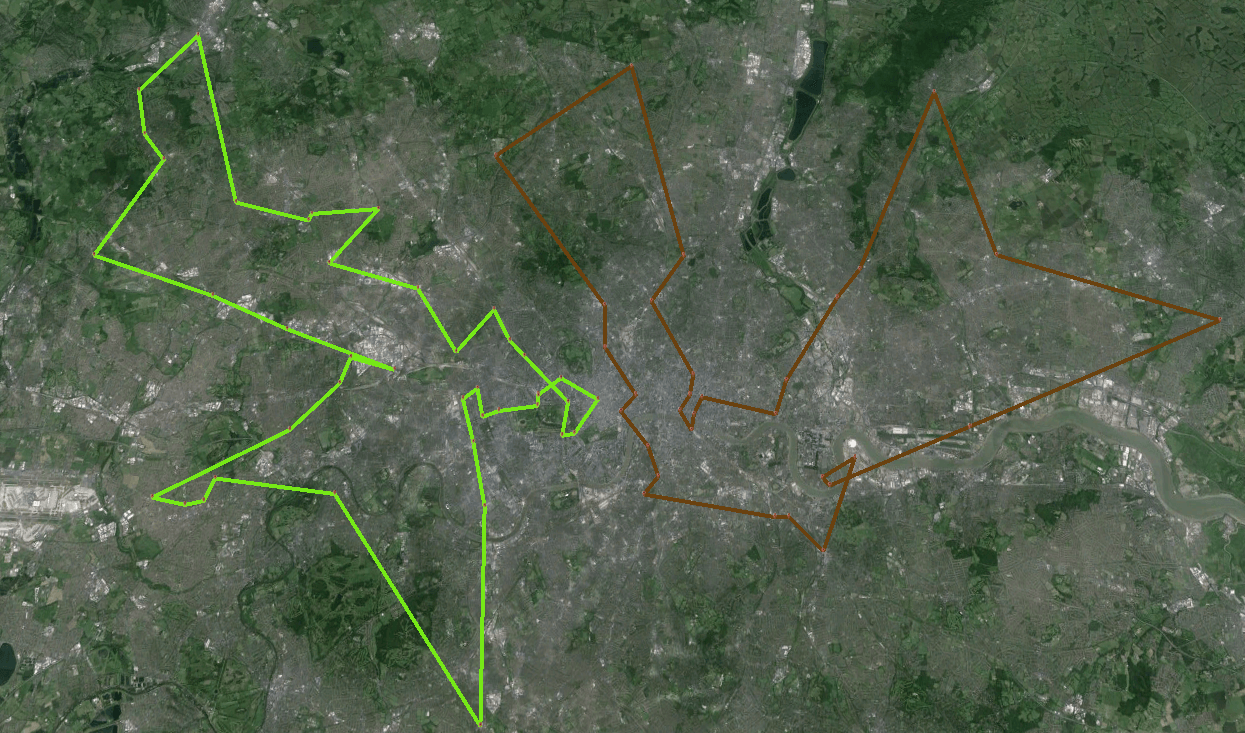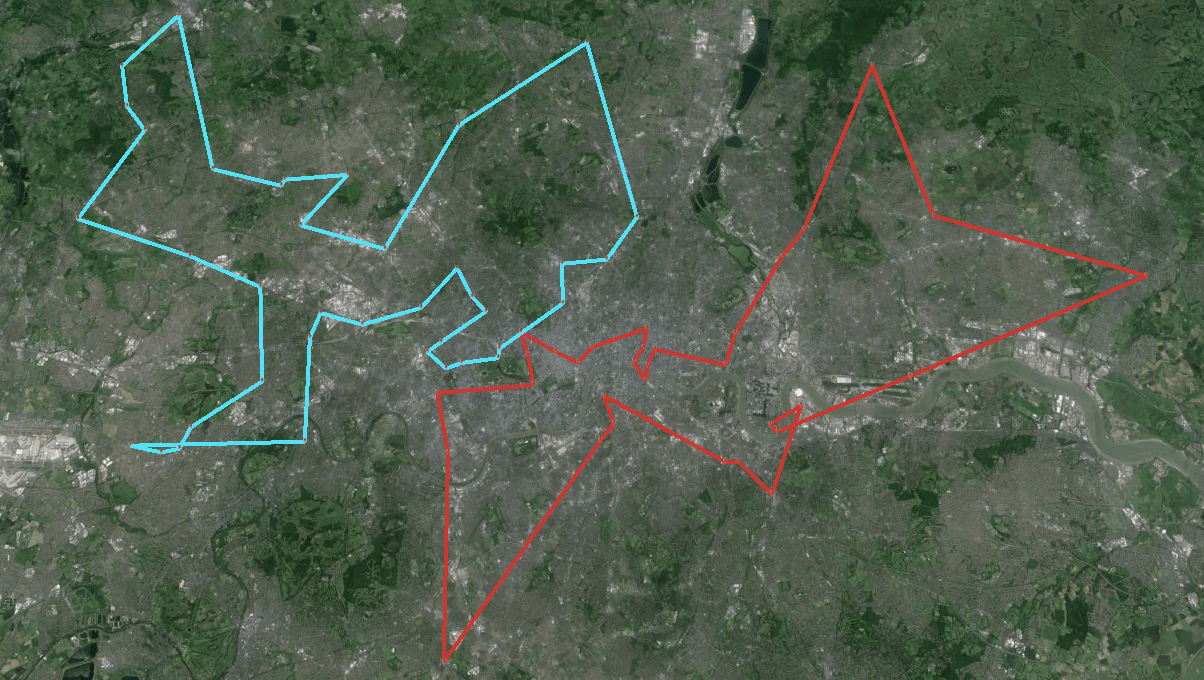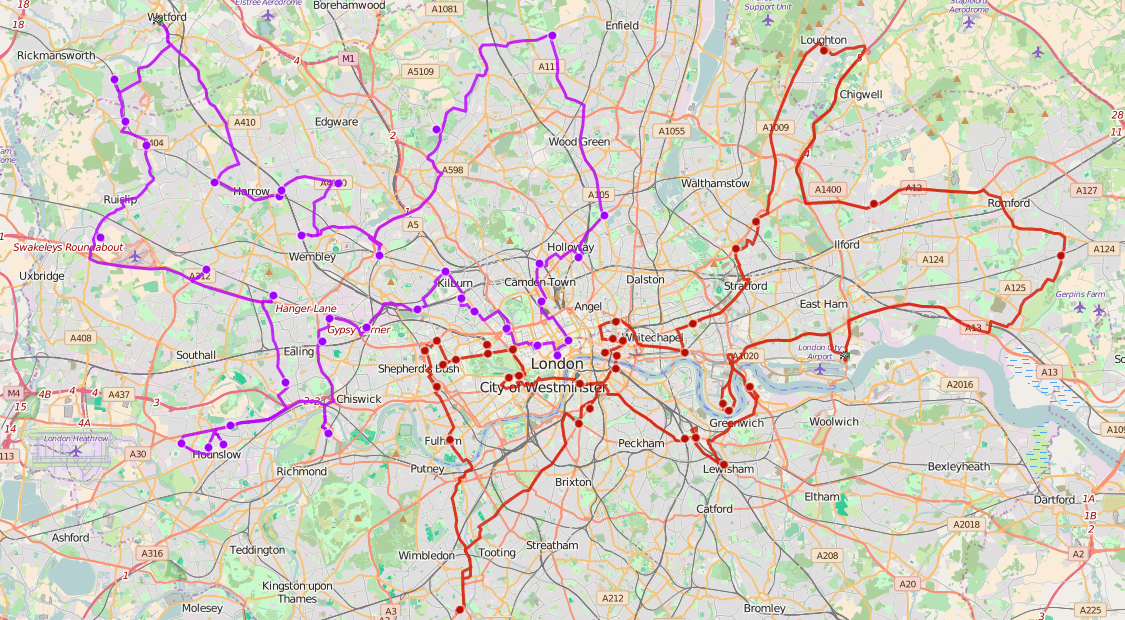Humans, oddly enough, are actually very good at coming up with reasonable solutions to route optimization problems. We rely on “common sense” to ensure we don’t end up sending vehicles all the way across town because we intrinsically understand this isn’t efficient. Computers don’t have this built-in understanding of efficiency so they are quite bad at solving this type of problem. Before we begin, however, let’s quickly define what we mean by “this type of problem”.
Multiple Traveling Salesman Problem
Imagine you have a bunch of salesman who have to visit a bunch of stops. What’s the most efficient way for them to visit all the stops? This is known as the multiple travelling salesman problem (mTSP). The mTSP is pretty famous in mathematics because it falls into a category of problem known as NP-Hard (Non-deterministic Polynomial Hard). One of the defining features of these types of problems is that it is not possible to know the solution unless you test every possibility. Unfortunately, the number of possibilities in a very modest type of route optimization can quickly spiral out of control. Let’s consider a delivery company that has to make 60 stops with a single vehicle. To test every possibility, we would start by picking a point (initially we have 60 possibilities), then another (59 possibilities), and another (58 possibilities), and so on until we had stopped everywhere. The number of permutations can be given by a function on your calculator called “bang” – it’s denoted by an exclamation mark. Since we have 60 stops, our equation for the number of permutations is given by: That’s a really big number. To put it into perspective, there are approximately 1080 hydrogen atoms in the entire universe. So in all the stars and planets and dust and gas in our solar system, in our galaxy, in the Andromeda galaxy, in our local cluster, in the entire super structure of all that exists, there are less hydrogen atoms than permutations in this seemingly simple problem. That’s why computers struggle with vehicle routing problems.
Optimizing routes
So humans are pretty good at working on this type of problem because we are able to take “common sense” shortcuts that end up giving us a pretty reasonable solution. The problem is that at some point even we become overwhelmed and simply can’t take into account all the factors required from modern businesses. Imagine you had the task of creating a schedule for 10 vehicles, with 300 stops, over the course of a week, having to keep in mind that each stop is either a pickup or delivery (with a certain capacity – you can’t overload the vehicles), each location takes a certain amount of time, as does the trips between the stops, but your vehicles only run from 9am to 5pm, so there are time limits as well as capacity limitations. Vehicles have different running costs – large trucks consume more fuel than lighter ones, but can carry more – they might also require drivers with specialized licenses who have a higher hourly rate. So you need to try and work out whether it is better to send a small vehicle a longer distance (bearing in mind that it can only visit a limited number of stops before its load capacity is reached), or send the larger vehicle because it also has capacity to deliver to other nearby stops. But, each delivery takes time so the person creating the schedule also needs to ensure that the truck’s route doesn’t leave it miles away from the depot at 4:58pm – meaning that the driver ends up being furious that he or she will get home late. Vehicles also come with a built in range before they have to refuel, so you can’t assume they can drive indefinitely without building in time for refueling stops and driver breaks. What happens when some deliveries can only be made at certain times? If several locations require deliveries at the same time, the scheduler has to ensure that all the vehicles are delivering to those locations at the right time while still keeping the overall costs to a minimum.
Human optimizations
In the scenario above, the amount of work a human would have to perform is pretty daunting. Companies pay very smart people to generate their schedules ahead of time. It’s hard, specialized work that costs a lot of money. But, to demonstrate how a human might approach this problem, let’s consider the following set of locations with two depots, each with a vehicle that has an operating time limit and a range limit (i.e. it may only travel 150Km per day). These limits, in the real-world, would depend on the unique resources and limitations of your own operation. But for now, here’s what we have:
Intuitively, we know that (unless there is a specific reason) sending the vehicle from the depot in south east (the orange marker towards the right of the map) to locations in the north west (top left of the map), near the second depot, is probably not going to be the most efficient way to do things. We might decide that it is a good idea to simply divide up the points roughly equally like this:
From there it is up to us to try create the most efficient individual routes for each vehicle in order to produce the solution. I actually gave it a bash. It’s really not easy. Here’s what I came up (full disclosure, I had to get some help) shown in Google Earth:
Not bad, right? There are a couple of cross-overs in each tour, but this is because London is full of one-way streets and is crisscrossed with rivers that mean vehicles have to find nearby bridges, which can affect the course of their optimal routes. But there’s a problem. Neither of these vehicles’ tours come in at less than 150Km – one came in at 151.1Km and the other at 150.4Km. You might think I’m being pedantic but, for big operations that rely on efficiency, small differences have a habit of working their way up the chain to become big problems. Simply put, I couldn’t do it. From my perspective, this problem cannot be solved. Maybe people with a lot more experience and time on their hands can give it a go and see if it is possible. But, all is not lost. There are software applications that offer route optimizations available. I used one of these to try and improve on my solution.
Computer optimizations
Because of the massive complexity involved in trying to calculate reasonable solutions, mathematicians and programmers have become pretty sneaky in the way they approach things. They abandoned traditional programming techniques and began to use heuristic algorithms, which can produce pretty good solutions in a reasonable amount of time. A heuristic algorithm can look for solutions among many possibilities, but not necessarily guarantee it finds the best one. One example of a heuristic algorithms is called the Ant Colony Optimization (ACO), which mimics the way an ant colony forages for food. Initially ants head out in all directions. If an ant finds a food source it runs back to the nest leaving a trail of pheromones. When the next wave of ants set out, some are influenced by the weak pheromone trail and follow it. If they too come across the same source of food, they rush back to the nest, leaving a stronger trail of pheromones that influences the following waves of ants more and more, until eventually the ants make a nice straight line between the nest and their food source. By taking sensible shortcuts, implementing a few heuristic algorithms, and making a few assumptions here and there, computer scientists can create a system than can outperform even the best humans. I applied one of these to my problem and came up with this result:
This is a better solution than I could manage, but it still broke the distance constraints of one of the vehicles – by less than 1Km. The other vehicle made it with a few hundred meters to spare. Ok, so we’re getting better. But this is a pretty simple problem. There aren’t delivery time windows, there aren’t vehicle and location constraints – i.e. does the vehicle need to have cold chain facilities, or be able to transport liquid volumes – or any of a myriad other potential stumbling blocks that might crop up in the real world. I did manage to run this particular problem on an enterprise system – to see if it is in fact possible.
Enterprise optimizations
There are significant differences in the quality of the solution between lightweight programs that use shortcuts (like basing cost calculations only on distance, or only on time) and built in assumptions (i.e. using human “common sense” to divide the map into areas each vehicle will deliver to), and ones that throw significant computing resources at complex real-world problems to produce unbeatable quality optimizations that genuinely produce significant savings on fuel, time, and costs. Instead of considering only distance or only time costs, enterprise systems must consider and measure both – just as both are factors in real world optimizations. A delivery truck might require two operators (i.e. a driver and an assistant to help unload) who work on hourly wages. This can have an impact on whether the system routes the vehicle via a shorter, but slower route, or a longer (but faster) one. Systems that only optimize the time taken, or the distance travelled, will never be able to get this fundamental balance of costs right because they only ever consider one or the other. Programs that use “common sense” shortcuts will also, by definition, miss out on potential solutions that aren’t intuitive to our minds – and there are many, many, many (uncountably many) of these. To generate our enterprise solution, I utilized Optergon, which is in use in over 60 countries around the world and integrates with transport, tracking and logistics companies via an API service. What makes Optergon interesting is that it doesn’t make use of so-called common sense shortcuts. Instead it relies on a combination of heuristic algorithms, including the ACO (mentioned earlier) and simulated annealing. Simulated annealing mimics the process of tempering steel, in which the metal is heated to get the atoms jiggling about with weaker bonds. The steel is then hammered forcing the atoms into a closer, more densely packed array as it cools. This process is repeated until the steel’s atoms are packed as tightly as possible. But cutting-edge algorithms and a system that teaches itself as it goes aren’t enough to tackle enterprise level problems on their own. Because of some curious features of the mTSP it is virtually impossible to avoid situations in which a solution “looks” great, but isn’t close to what the actual best solution looks like. This is what’s known as a “local minimum”, and is a tricky problem to overcome because you don’t know ahead of time whether the system has found a genuinely good solution, or a local minimum. In order to get around this, Optergon had to implement a massively parallel architecture that allows it to work on the same problem, and specific aspects of the problem, at the same time across hundreds of different processes. Sharing tidbits of information and gleaning new insight at every step of the way, Optergon’s individual processes make use of existing and proprietary heuristics to teach the overall system how to generate an unbeatable solution With all this in mind, our current problem turns out to be possible. Here’s the solution:
Solution courtesy of 3DTracking, integrated with the Optergon route optimization API In this solution, each vehicle arrives back at the depot within the bounds of the constraints set – one vehicle made it in 148.3Km, and the other in 147.9Km. Pretty tight, but valid. So why am I going on about the difference between a few kilometres? Well, for a start, you wouldn’t want a system that generates a magnificently cost effective solution that requires your vehicles to travel 2000 miles on a single tank of gas, carrying 30 tonnes of cargo that it doesn’t have capacity for, arriving at locations at the wrong time, and so on. An enterprise solution must produce the most cost effective solution possible within the real-world bounds dictated by the business. Which brings me to my next point… Not only did this optimization reduce our costs, it also showed us something we didn’t know before – whether or not it was actually possible to successfully visit all the locations within the given restraints. This makes a system like Optergon useful for determining whether or not it’s even possible to attempt certain things. A good example of where this is useful might be when transport companies quote for business. If they are able to run accurate optimizations on transport contracts before delivering a quote they can be much more accurate and competitive because they know exactly what is possible, and how much it will cost them.
Comparing costs
So, apart from the fact that two out of three solutions weren’t valid, what were the differences in cost? Bearing in mind that it is more important to produce a solution that is valid (i.e. possible within the constraints of the business) than a cheaper one that is not. It’s important to compare the distance and times provided by each solution as the cost is essentially an arbitrary reflection of these two components – for the sake of making the math a bit easier, I set the time and distance cost of $5 per hour and $5 per km respectively. Real businesses would need to input values that reflected their operation accurately in order to derive the correct costs – although, since the costs are the same for all three optimizations, we can also look at the percentage difference in costs to determine how much better one solution is over another.
Human solution (with help) – Invalid
Unit 1 (North west depot)
Distance: 151.1Km Time: 35191 seconds Cost: $824.41
Unit 2 (South east depot)
Distance: 150.4Km Time: 32480 seconds Cost: $817.17
Overall cost: $1641.58
Computer solution – Invalid
Unit 1 (North west depot)
Distance: 150.9Km Time: 33856 seconds Cost: $821.65
Unit 2 (South east depot)
Distance: 149.8Km Time: 34046 seconds Cost: $816.63
Overall cost: $1638.28
Enterprise solution – Valid
Unit 1 (North west depot)
Distance: 148.3Km Time: 33142 seconds Cost: $807.85
Unit 2 (South east depot)
Distance: 147.9Km Time: 34464 seconds Cost: $807.50
Overall cost: $1615.35 In essence, the enterprise solution provided by Opteron produced a valid result that was in the region of 1.5% – 2% better than a human (with help), and a human using routing software. Although, this is a very simple problem and that gap would widen up quickly as more and more vehicles and stops were added – but 60 points was more than enough for me. For a company doing a few hundred locations a day, the improvements might be nearer to 10%, or 15%, depending on how good their existing optimizations are. Ok, so a couple of percent might not sounds like much. But, anyone who works in a logistics company and knows how much transport costs are would jump at the chance to shave entire percentage points off their costs. This might equate to millions of dollars being saved every year for even moderate sized organizations. Don’t forget about the fact that better route optimizations mean less distance travelled, which not only saves on fuel but also on labor and vehicle wear-and-tear costs. And fuel costs are only ever going to go up in the long run (assuming the global economy recovers at some point) so saving on fuel will become more and more of a financial imperative as time goes by. And, let’s not forget about the fact that if companies are travelling up to 10% less, then 10% less carbon is being pumped into the atmosphere. Not using enterprise route optimization is not only wasteful in terms of cost, it’s unnecessarily bad for the environment. Additionally, if you know ahead of time what the optimal way to perform your pickups and deliveries are, it means you also know how to pack the vehicles. Obviously, packing the vehicle is important because you don’t want to arrive at the first stop and have to unpack the entire truck to get at the first item to be delivered. If you know how to pack the trucks, you also now how to stock the warehouse so that the packers can operate as efficiently as possible, working quickly because everything they need is warehoused in a convenient location. In this way, having enterprise level route optimizations not only saves on transport but can also serve to maximize the efficiency of your operation up and down the chain, from the warehouse to delivery. Featured photo credit: Daniel Gimbert via flickr.com
